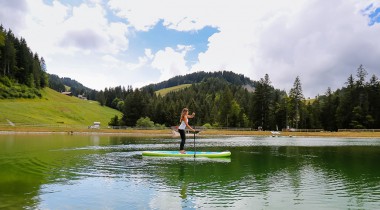21.03
2012
Mountain activities
What could be better than stepping directly out of your hotel and onto your skis? Ideal for vacationers, many French ski stations are laid out in this pedestrian-friendly manner.
What could be better than stepping directly out of your hotel and onto your skis? Ideal for vacationers, many French ski stations are laid out in this pedestrian-friendly manner.
Most pedestrian ski stations were built in the 1960s, including La Plagne (1961), Les Ménuires (1963), Flaine and Le Corbier (1967) and Les Arcs (1968). At that time, pragmatism outweighed all other considerations. The architectural style of the day was heavily influenced by Le Corbusier, who put a strong emphasis on functionality. Le Corbusier believed that buildings should respond to man’s four principal occupations: work, shelter, mobility and entertainment. Originally created for an urban setting, his model was applied to the mountains resorts. When the initiative was launched in the 1960s, it was supported by the state, which wanted to take advantage of the growing national interest in winter sports.
Unlike today, tourists came to the stations for the sole purpose of skiing. It was common for vacationers to spend 8 hours per day on the pistes, meaning less time strolling through the streets or relaxing on their balconies. It was necessary for the architecture of the stations to respond to this lifestyle, hence the imposing buildings situated directly at the foot of the pistes. This desire for maximum functionality also explains the construction of commercial galleries on the main floor or in the basements of the buildings, allowing guests to do their shopping in their slippers so as not to waste time.
Car-Free stations
The majority of “third generation” resorts were created with children’s safety in mind, meaning accommodation situated close to the chairlifts and the separation of cars, skiers and pedestrians. The “Family Vacation” theme is central to these stations, meaning children should be able to take maximum advantage of the holiday, giving parents the possibility to benefit from the time as well, all within a manageable budget.
Certain stations have developed distinct identities, thanks to the ingenuity of their promoters. The example that comes to mind is Avoriaz, which opened in 1967. Creators Robert Brémond and his son Gérard (the founders of Pierre&Vacances) imagined a car-free station, where the streets were also ski pistes. At the Arc 1600 station, the architect Denys Pradelle seamlessly integrated long rows of buildings into the landscape. An example is the 225-unit “Versant Sud” residence, which shadows the slope of the pistes, meaning it is invisible from a distance despite its size (13 storeys, 120 metres long.) Current architectural trends in the stations were inspired by this same movement, combining functionality and integration into the natural landscape.






